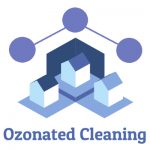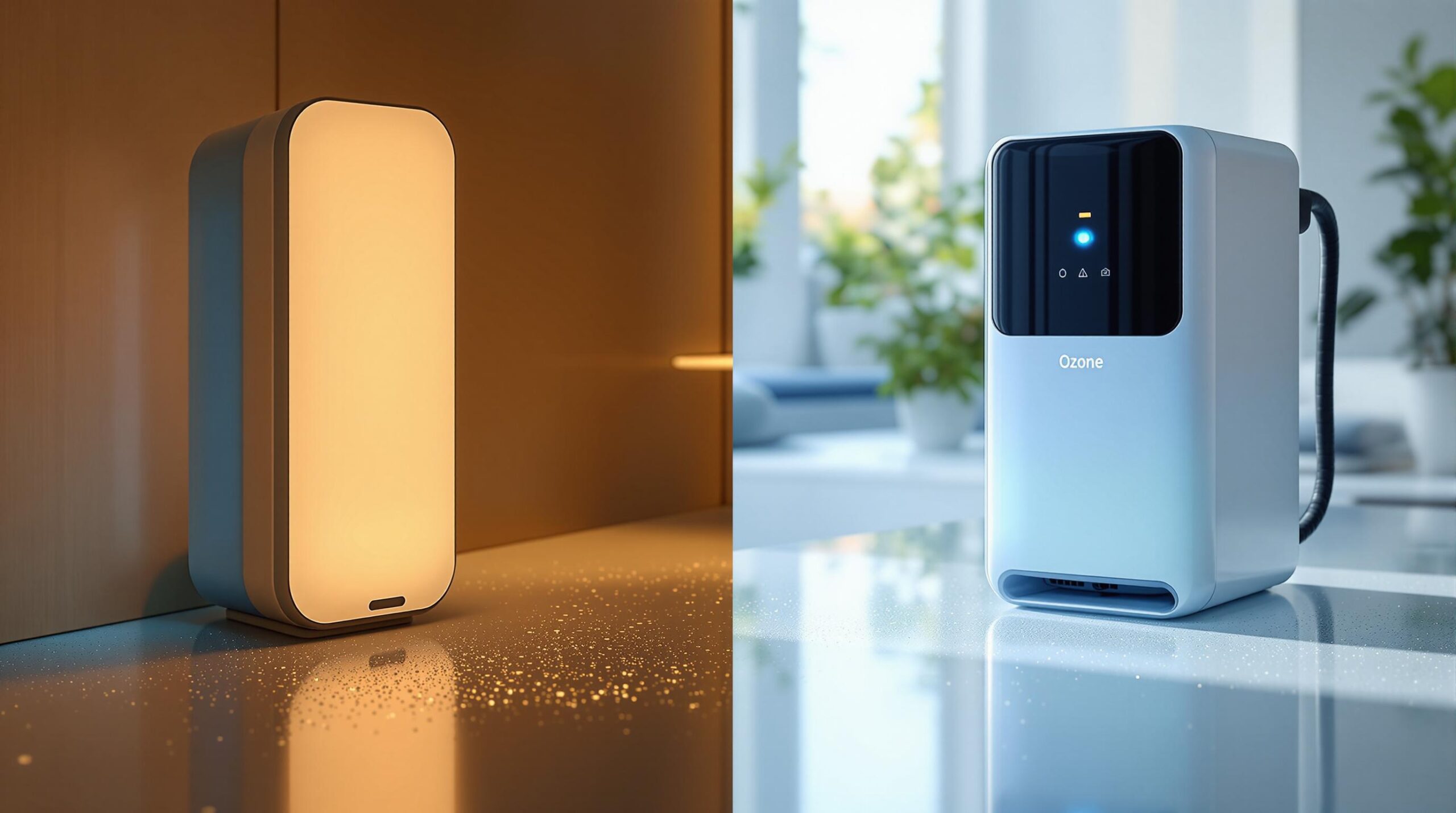Looking for the best cleaning method? Here’s the deal:
- Ozone cleaning works fast to eliminate odors in unoccupied spaces but requires proper ventilation after use.
- Hydroxyl cleaning is safe for use around people and pets, operates continuously, and targets a wider range of contaminants, though it works slower.
Quick Comparison
| Feature | Ozone Cleaning | Hydroxyl Cleaning |
|---|---|---|
| Speed | Fast odor removal | Slower, continuous process |
| Safety | Requires evacuation | Safe for occupied spaces |
| Effectiveness | Strong oxidizer | More reactive, broader range |
| Post-treatment | Ventilation needed | No additional steps |
| Material Impact | May damage materials | Safe for belongings |
Choose ozone for quick, intensive treatments in unoccupied areas. Choose hydroxyl for safe, ongoing cleaning in spaces where people are present.
Ozone Cleaning Process
How Ozone Removes Odors
Ozone works by oxidizing odor molecules directly at their source. This process breaks down bacteria and organic compounds without relying on additional chemicals.
Advantages of Ozone Cleaning
Ozone cleaning provides several perks when it comes to odor removal and air sanitization:
| Advantage | Details |
|---|---|
| Chemical-free | Safe, non-toxic, and hypoallergenic |
| No chemical residue | Leaves behind no harmful residues |
| Flexible application | Can be adapted for various spaces |
Limitations of Ozone
- Ozone levels above 0.05-0.1 ppm can irritate the respiratory system, so spaces must be unoccupied during use.
- Prolonged exposure can harm materials like rubber, plastics, fabrics, and even paints or coatings.
- It doesn’t work for mold remediation.
- Proper ventilation and testing are necessary before re-entering treated spaces.
Next, we’ll look at hydroxyl technology, which addresses similar issues but operates safely in occupied spaces and avoids material damage.
Hydroxyl Cleaning Process
How Hydroxyl Removes Odors
Hydroxyl radicals (OH•) work by oxidizing odors, volatile organic compounds (VOCs), bacteria, viruses, and mold spores. This makes them effective for cleaning and deodorizing a variety of environments.
Advantages of Hydroxyl Cleaning
Hydroxyl cleaning stands out for its unique benefits compared to traditional methods:
| Advantage | Explanation |
|---|---|
| Safe for Occupied Spaces | Can be used continuously without requiring evacuation of people or pets |
| No Residual Chemicals | Leaves no lingering chemical smells or harmful residues |
| Wide Range of Effectiveness | Neutralizes odors, VOCs, bacteria, viruses, and mold |
| Protects Belongings | Does not harm materials or personal items |
Hydroxyl Limitations
While hydroxyl cleaning operates effectively in occupied spaces, it works at a slower pace compared to ozone treatments. Up next, we’ll directly compare the ozone and hydroxyl methods.
Direct Comparison
Side-by-Side Comparison
| Feature | Ozone Cleaning | Hydroxyl Cleaning |
|---|---|---|
| Speed | Fast odor removal | Continuous process |
| Safety | Requires evacuation | Safe for occupied spaces |
| Reactivity | Strong oxidizer | Much more reactive than ozone |
| Application Range | Air and surface sanitization | Targets airborne pathogens |
| Treatment Duration | Short-term intensive | Ongoing operation |
| Post-treatment Steps | Ventilation needed | No additional steps |
| Space Usage | Area must be vacant | Activities can continue normally |
Use the guide below to determine which method suits your situation.
Method Selection Guide
Consider speed, safety, and application needs when deciding:
Opt for Ozone Cleaning If:
- You need quick odor removal in a specific, unoccupied area.
- Both air and surface sanitization are required.
- You’re okay with a fast treatment followed by a ventilation period.
Opt for Hydroxyl Cleaning If:
- You need a continuous solution for occupied spaces.
- Safety for people and pets is a priority.
- You want effective odor and pathogen removal without interruptions.
Each method has its strengths depending on your requirements. Ozone cleaning is ideal for rapid, focused treatments but demands strict safety measures. Hydroxyl cleaning, on the other hand, offers ongoing air-quality improvement without disrupting daily activities.
sbb-itb-5fea4da
Where to Use Each Method
Ozone Applications
Ozone is best suited for unoccupied spaces where quick odor removal is needed. Common uses include:
- Vacant Properties: Empty homes, new builds, and foreclosed buildings
- Transportation: Stored trucks, RVs, and boats
- Commercial Spaces: Hotel rooms, restaurant kitchens, and storage units
Ozone works quickly to neutralize odors, making it ideal for spaces without occupants.
Hydroxyl Applications
Hydroxyl systems are designed for continuous use in areas where people are present. They’re often used in:
- Healthcare Facilities: Hospital waiting rooms, medical offices, and long-term care centers
- Public Venues: Schools, government buildings, and shopping centers
- Hospitality Settings: Hotels, restaurants, and conference centers
These systems operate safely around people and materials, making them perfect for occupied environments.
Difference between Ozone and Hydroxyls
Making Your Choice
Now that you’ve reviewed the pros and cons of each method, take a look at the comparison table for detailed metrics. Ozone technology works well for quick treatments in spaces without occupants, while hydroxyl systems allow for ongoing operation in areas where people are present.
Next Steps
Use this simple checklist to choose and implement the best cleaning solution:
- Determine Your Needs
Decide if you require fast treatment in unoccupied areas (ozone) or a solution that works safely in occupied spaces (hydroxyl). Consider material sensitivity and how much time you have for the project. - Consult an Expert
Reach out to a certified technician to confirm your choice and arrange service.
Make sure your choice aligns with your timeline, safety considerations, and the specific needs of your space for the best outcome.
FAQs
What impact does ozone cleaning have on different materials over time?
The long-term effects of ozone cleaning depend on the material’s resistance to ozone exposure. Some materials, like aluminum, ceramic, copper, and stainless steel 316, are highly resistant and remain unaffected under normal conditions. Others, such as ABS plastic, brass, and EPDM, may tolerate ozone for short durations or at lower concentrations but could degrade with prolonged exposure.
Materials with poor resistance, like Buna N (nitrile) and natural rubber, are prone to significant oxidation damage and should be avoided when using ozone cleaning. For best results, always verify the ozone compatibility of materials before use to ensure durability and effectiveness.
How can I decide between ozone and hydroxyl cleaning methods for my needs?
Choosing the right cleaning method depends on your specific situation and priorities. Ozone machines are highly effective for quickly eliminating strong odors, such as those caused by fire or water damage. However, they require unoccupied spaces during use due to potential health risks and may damage certain materials. On the other hand, hydroxyl generators provide a safer option for continuous odor removal in occupied spaces, like homes, offices, or hospitals. They are effective against a wide range of odors and pathogens but work more gradually compared to ozone machines. Consider your environment, safety requirements, and cleaning goals to determine which method suits you best.
Can hydroxyl cleaning remove mold and bacteria, or is it mainly for eliminating odors?
Hydroxyl cleaning is highly versatile and effective. It not only neutralizes unpleasant odors and volatile organic compounds (VOCs) but also targets bacteria and mold spores in the air and on surfaces.
This method is safe for use in occupied spaces, making it a practical choice for environments like homes, offices, and healthcare facilities. While it’s excellent for odor removal, its ability to sanitize and address mold and bacteria makes it a comprehensive air purification solution.


Recent Comments